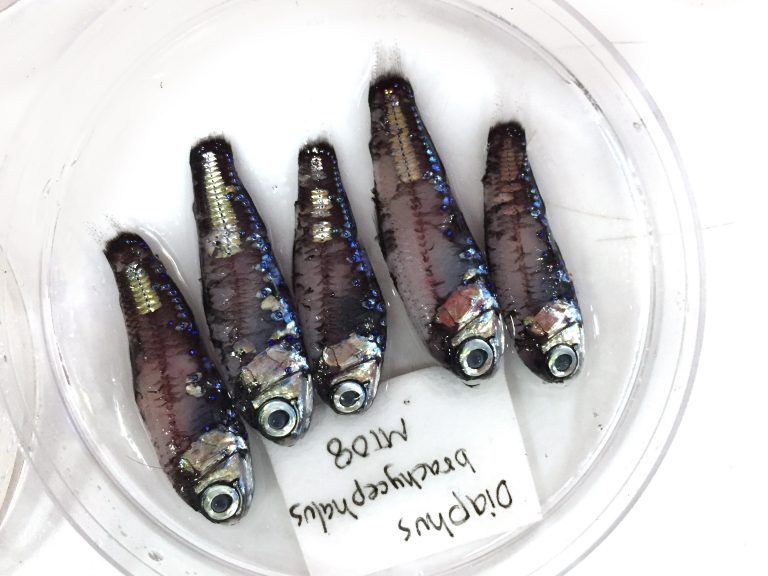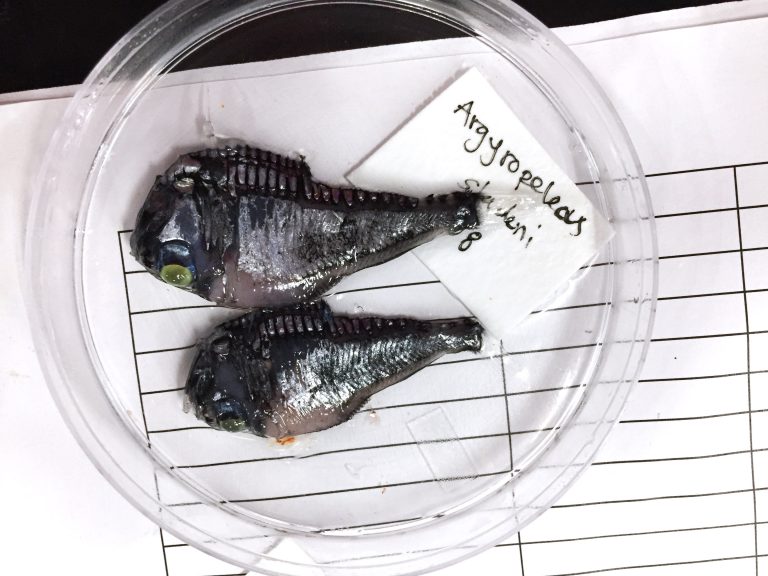It is early in the morning and the day is barely starting for most of those on R/V Falkor – but not for Dr. Amanda Netburn or PhD. Candidate Elan Portner. Immune to the long hours behind them, the duo remains cheerful and lively as they sort the different samples they have collected through the night, including lanternfish, jellies, shrimp, and squid. Yet today there is a clear favorite: a shark.
It might not be a white shark, but this cookie cutter shark is an impressive animal nonetheless. “They’ll swim up to a tuna or a large fish and just take a bite out of it, like a melon ball,” explains Dr. Salvador Jorgensen, marine ecologist. All sharks have replacement teeth, but if cookiecutter sharks lost only one tooth at a time, they would not be able to get a clean scoop out of their prey, so they lose the whole row at a time, which is swiftly replaced by a whole new one.
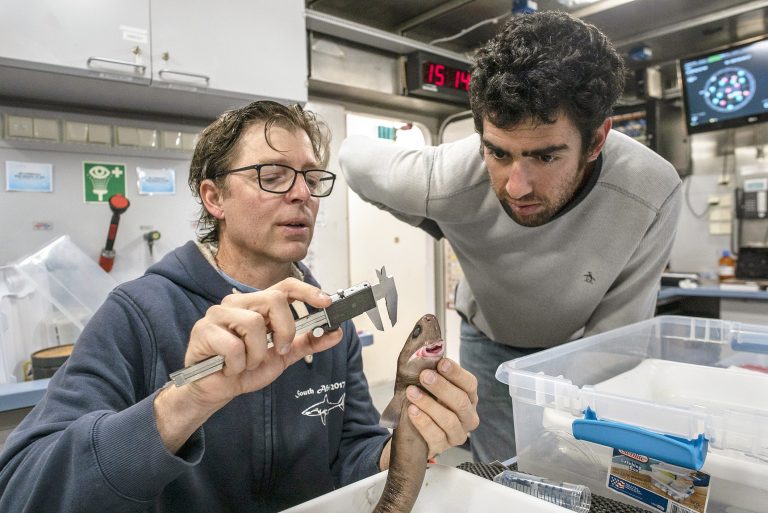
Deep Scattering Layer
Curious eyes visit the wet lab constantly as Amanda and Elan sort their way through samples gathered in the “peanut butter of the ocean,” as Chief Scientist Dr. Barbara Block sometimes refers to the deep scattering layer, due to its important role within the oceanic food web. This layer exists throughout the global ocean at depths between 200 to 1000 meters and – like peanut butter – can be found nearly everywhere, providing a caloric snack for hungry predators who dive into these layers. This nutritious layer is a horizontal zone composed of living organisms that take part in the largest mass migration on our planet. The organisms protect themselves from the larger predators by taking refuge in the darkness of deep waters, but at night when sunlight no longer penetrates the surface of the ocean, they migrate upwards to feed on plankton. This is why the midwater ecology duo Elan and Amanda work at night.
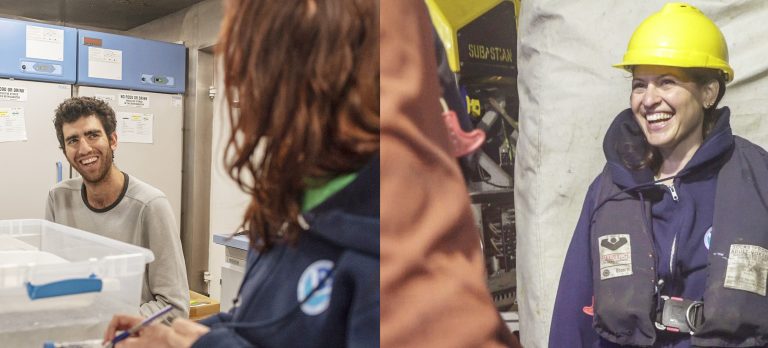
Scoop Them Up
The experts onboard Falkor are trying to understand why white sharks congregate in this part of the ocean, and in order to do so, they are conducting an exhaustive characterization of the area. Acoustics and net tows are among their techniques. “We have brought a midwater net. It is ten meters long, and its mouth opening is about four square meters. We brought it because we are interested in sampling these small forage organisms that we think might inform the sharks behavior,” says Elan, a doctoral student at Stanford University’s Hopkins Marine Station.
Throwing a net off the side side of Falkor and dragging it for a short time to capture organisms might sound simple, but the work of the midwater team is far from easy. The determination and effort necessary is astounding.
To begin with, the team examines the Simrad ek60 echo sounder and identify the exact location in the water column to conduct the two different types of tows, both during the nighttime. A shallow night tow targets the high number of animals that swim up to the surface when it is dark. “But we also are interested in organisms that don’t migrate, so we have a deep night trawl that will sink to about 500 to 600 meters. We can then compare the composition of the samples, and infer which are found only in the surface and which are not migratory and live at depth,” Elan says.
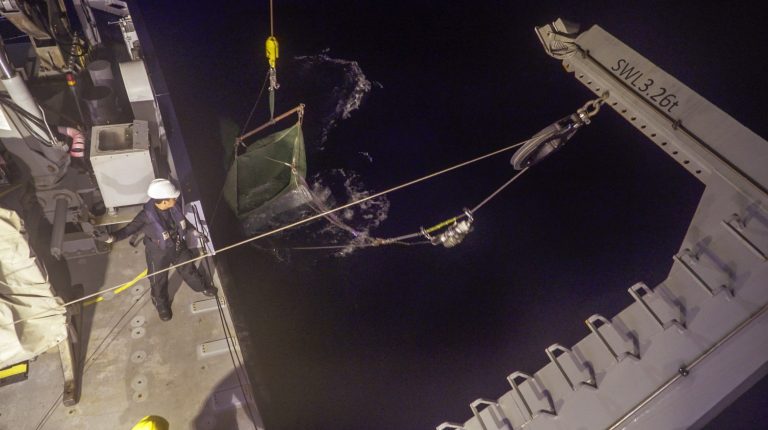
After the net is deployed from Falkor’s J-Frame crane, the duo dedicates the next hours to examining the images produced by the echo sounder, locating the scattering layers and determining each of their depths. This is precisely how the layer was first discovered when it was originally mistaken for the ocean bottom: because the organisms are different densities than water, they scatter or reflect the sound waves produced by the echosounders transducer (hence the name deep scattering layer). The team also needs to make sure that they target the different sub-layers that compose the deep scattering layer, so nothing is missing from the sample they collect. The net is also equipped with a CTD, so the scientists are aware of its depth. After spotting the “peanut butter layer,” the duo communicates with the winch operator, directing the net to that precise depth.
Making Sense of It
Once the net is back onboard, their work is far from over. The scientists will spend the next four-to-six hours sorting out all of the creatures they have collected, eventually coming up with a biodiversity index for the location. The first step is to make a general measurement of all the organisms in the sample through displacement volume. By pouring water into a graduated cylinder and then adding the organisms, the experts then measure the rise of the water and get an estimate of the actual biomass.
Lanternfish are the most common organism found in the samples. Indeed, lanternfish are among the most widely distributed, populous, and diverse of all vertebrates, which is why they play an important ecological role as prey for larger organisms. There are about 250 different species of lanternfish around the world, and Dr. Netburn estimates their tows have collected around 15 to 20 different species so far, along with numerous other fish species found only in deep waters – such as dragonfish, bristlemouths, and lightfish. In order to identify them, the team needs to draw upon some old school techniques, consulting books and following the clues set by dichotomous keys. By answering yes or no to a series of questions, they are able to zero in a reliable identification. Photophores, for instance, are light-producing organs which are distributed in patterns along the body in some species. The differences might be minuscule, so the challenge is, ironically, huge. The scientists take time to analyze each specimen’s photophore distribution and ascertain what that specimen actually is. Every organism larger than two centimeters is measured, and all of this information is entered into a log. Also, for each unique organism a DNA sample is taken and frozen for later analyses.
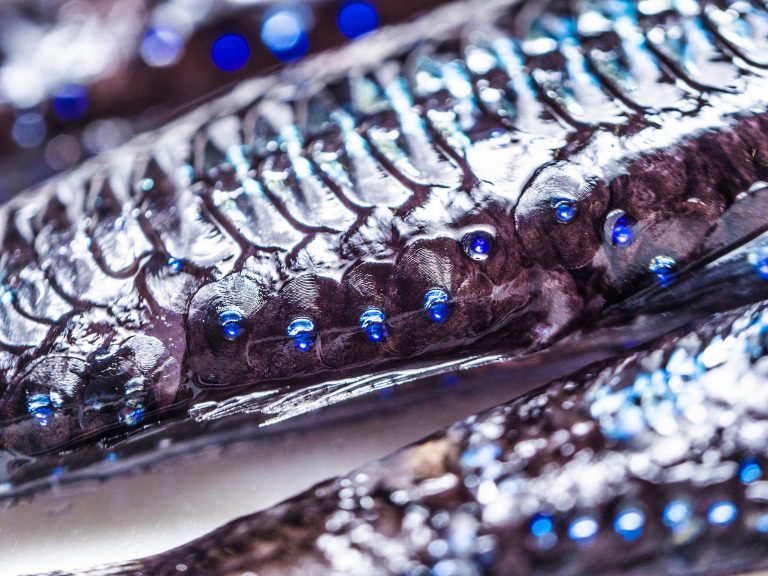
Bountiful
It is difficult for Dr. Netburn to determine if what they have collected so far is extraordinary, as there is no baseline to compare their findings to. “No one has collected in these waters before, so I don’t know how unusual what we’re finding really is,” she shares. “But I can tell you I’m surprised by the diversity of organisms we’ve sampled.”
As the white shark voyage progresses, the midwater duo continues their thorough examination of the “peanut butter layer,” a source of energy and nutrients for the rest of the ocean. How it connects to the story of white sharks in the Café is a question that the experts will explore in the future – and to do so, the unrelenting work of this enthusiastic duo will be essential.
